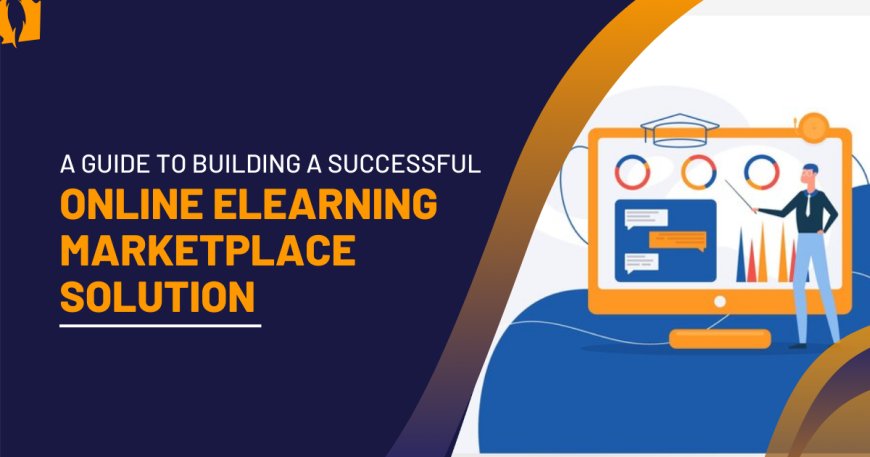A Guide to Building a Successful Online eLearning Marketplace Solution
Discover essential steps to create a successful online eLearning marketplace solution. Explore strategies for growth, user engagement, and lasting impact.

As online education continues to grow, the demand for online eLearning marketplace solutions has increased significantly. These platforms connect instructors and learners in a single, convenient space, offering a variety of courses across multiple disciplines. Building a successful online learning and teaching marketplace requires a well-planned structure, technical insight, and careful attention to user experience. This guide provides a step-by-step approach to creating an effective and scalable eLearning platform.
Understanding Online eLearning Marketplace Solutions
What is an Online eLearning Marketplace?
An online eLearning marketplace is a platform where educators can offer courses and students can enroll in them. This type of solution acts as a virtual classroom, allowing instructors to share content, engage with students, and manage coursework. It also provides learners with access to a diverse range of educational resources, enabling them to learn at their own pace.
Key Benefits of eLearning Marketplaces
-
Flexibility and Convenience: Learners can access courses anytime, anywhere, and at their own pace.
-
Global Reach: Instructors can reach a wider audience, while students can access courses from experts around the world.
-
Cost-Effectiveness: eLearning marketplaces are generally more affordable for learners compared to traditional education.
According to a report by Research and Markets, the eLearning market is expected to reach $375 billion by 2026, indicating the growing demand and investment in this space.
Essential Features of an Effective eLearning Marketplace
To build a competitive eLearning marketplace, specific features must be included to ensure a smooth and engaging experience for users. Here are some critical features to consider.
1. User-Friendly Interface
A clear and intuitive user interface (UI) is essential for retaining users. The UI should allow easy navigation, quick access to courses, and straightforward account management. A simple layout with minimal clicks to reach course content can improve user satisfaction and retention.
2. Course Management System (CMS)
A robust CMS allows instructors to create, update, and manage course content efficiently. Key components of an effective CMS include:
-
Content uploading: Easy upload of multimedia such as videos, PDFs, and audio files.
-
Content organization: Ability to organize lessons into modules or sections for structured learning.
-
Assignment management: Tools for creating assignments and tracking student submissions.
3. Payment and Subscription Options
Online learning and teaching marketplaces should provide secure payment gateways to facilitate transactions. Options for one-time payments, subscriptions, and even pay-per-module pricing can increase flexibility for learners.
4. Interactive Communication Tools
For an online eLearning marketplace to be engaging, it must include tools for interaction between students and instructors, such as:
-
Live chat: Real-time messaging during classes.
-
Discussion boards: Forum-style discussions for students to share insights.
-
Video conferencing: For virtual classrooms and interactive sessions.
5. Progress Tracking and Analytics
Tracking progress motivates students and gives instructors insights into their performance. Some critical progress-tracking features include:
-
Quizzes and assessments: Tests after each module to check understanding.
-
Certification: Provide certificates upon course completion as a value-add for learners.
-
Student analytics: Insights into learning patterns, completion rates, and time spent on each module.
6. Ratings and Reviews System
A transparent rating and review system allows students to leave feedback about courses, helping others decide which courses to take. It also motivates instructors to maintain high-quality content.
7. Mobile Compatibility
A mobile-friendly or dedicated mobile app version of the platform ensures that students and instructors can access the marketplace from any device. With 57% of global users accessing online platforms through mobile devices, this is essential for increasing reach.
Key Steps in Building an Online eLearning Marketplace Solution
Step 1: Define Your Niche and Target Audience
Determining a niche can help your marketplace stand out. A niche could be as broad as business skills or as specific as coding for children. Defining the target audience (e.g., high school students, working professionals) helps in tailoring content and marketing efforts.
Step 2: Choose a Suitable Platform
There are two main routes for developing an eLearning marketplace:
-
Custom Development: Building the platform from scratch offers complete control over functionality but requires significant time and resources.
-
Ready-Made Solutions: Platforms like Moodle, LearnDash, and Teachable offer pre-built structures for eLearning but may have limitations in customization.
Step 3: Select the Right Technology Stack
Choosing the correct technology stack is crucial for the platform's functionality, scalability, and performance. Common technologies for an online eLearning marketplace include:
-
Frontend: React.js, Angular, or Vue.js for a responsive and dynamic user interface.
-
Backend: Node.js, Python (Django), or PHP (Laravel) for handling server-side functions.
-
Database: MySQL or MongoDB to store user data, course content, and transaction history.
-
Cloud Storage: AWS S3 or Google Cloud Storage for scalable and secure data storage.
-
Payment Gateway: Integration with Stripe, PayPal, or other secure payment options.
Step 4: Develop and Implement Core Features
During development, focus on implementing the essential features discussed earlier. This includes building a CMS, integrating communication tools, and ensuring mobile compatibility. It’s advisable to adopt an agile approach to development, allowing for incremental improvements based on user feedback.
Step 5: Testing and Quality Assurance
Thorough testing is crucial for identifying and fixing issues before launch. Conduct tests for:
-
User interface (UI): Check for easy navigation, quick load times, and responsiveness.
-
Security: Protect user data and transactions using SSL and regular security audits.
-
Performance: Ensure smooth functionality with high traffic using load testing.
Testing phases should include alpha testing by internal teams and beta testing by a small group of target users.
Step 6: Launch and Marketing
Once the platform is ready, focus on launching and promoting it. Effective marketing channels include:
-
Social media: Platforms like LinkedIn, Facebook, and Instagram to reach learners.
-
SEO: Optimize website content to rank for relevant keywords.
-
Email marketing: Target potential learners and instructors with newsletters and offers.
Investing in influencer partnerships and offering discounts during the launch phase can also drive initial user adoption.
Ensuring Platform Security and Compliance
In online eLearning marketplaces, security and privacy compliance are paramount. Platforms must protect both user data and intellectual property. Some key steps include:
-
Data encryption: Encrypt sensitive data such as login credentials and payment information.
-
Access controls: Limit access to course content only to enrolled students.
-
Compliance with regulations: Adhere to global standards like GDPR for data protection.
Monetization Strategies for Online Learning and Teaching Marketplaces
Monetization is a critical aspect of building a sustainable online eLearning marketplace. Some effective monetization models include:
-
Subscription Model: Offer monthly or annual access to all courses.
-
Commission-Based Model: Charge a percentage fee on each course sold, typically between 5% to 15%.
-
Freemium Model: Provide free basic courses, with premium courses available at a fee.
-
Advertisement-Based Model: Display relevant ads on the platform, though this may impact user experience.
Case Study Example: Udemy's Revenue Model
Udemy, one of the largest eLearning marketplaces, primarily uses a commission-based model where they take a percentage of each sale. They also offer discounts and coupons to attract learners, making high-quality courses affordable. With over 50 million students worldwide, Udemy’s monetization strategies have proven highly successful, contributing to the platform’s strong market presence.
Current Trends and Future of eLearning Marketplaces
1. Artificial Intelligence (AI) and Personalization
AI-driven recommendation engines are becoming popular in eLearning platforms. These engines suggest courses based on user behavior and preferences, enhancing engagement. For example, Coursera uses AI to suggest courses based on users’ past activity and skills.
2. Gamification
Gamification is an effective way to improve course completion rates. Platforms can include features like points, badges, and leaderboards to make learning interactive. According to a study by TalentLMS, 83% of learners feel more motivated with gamified elements in courses.
3. Virtual Reality (VR) and Augmented Reality (AR)
VR and AR provide immersive learning experiences, particularly in areas like medical training and engineering. By 2025, the global AR and VR market in education is expected to reach $12.6 billion, indicating strong demand for these technologies.
4. Microlearning
Microlearning breaks down content into smaller, manageable sections. This approach is effective in capturing learners’ attention and improving retention, as courses can be completed in brief sessions rather than long lectures.
Conclusion
Building an online eLearning marketplace solution involves careful planning, technical expertise, and a focus on user experience. By understanding the essential features, selecting the right technology stack, and implementing effective monetization strategies, businesses can create a platform that attracts both instructors and learners. With the ongoing growth of eLearning, investing in a marketplace solution can provide long-term value, establishing a strong presence in the competitive online learning industry.
What's Your Reaction?

























